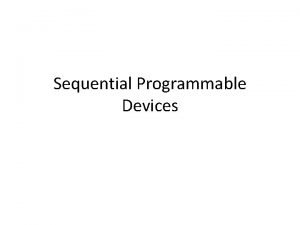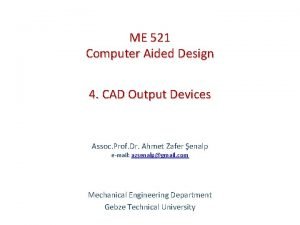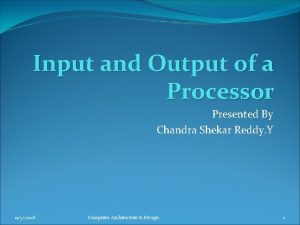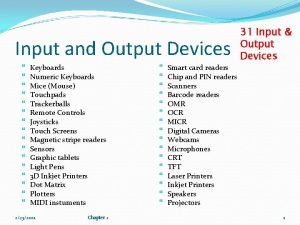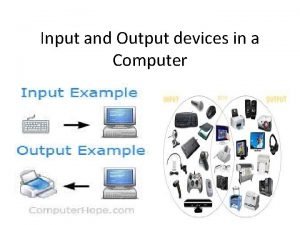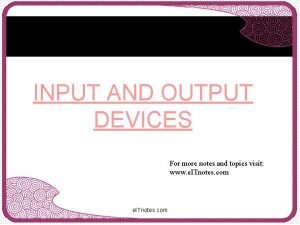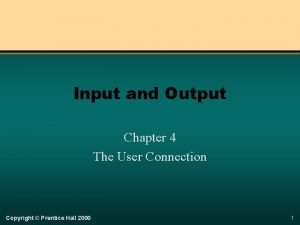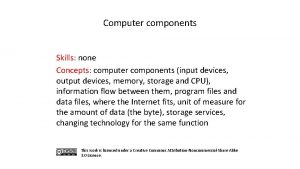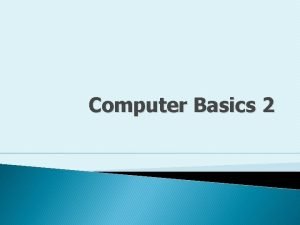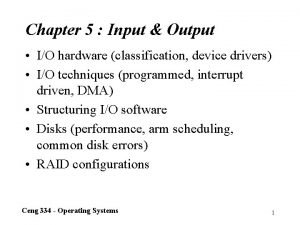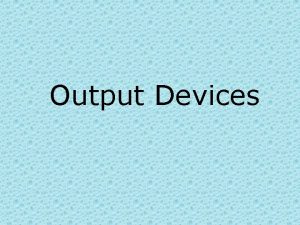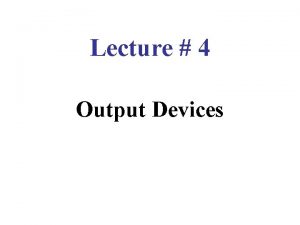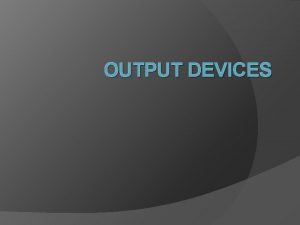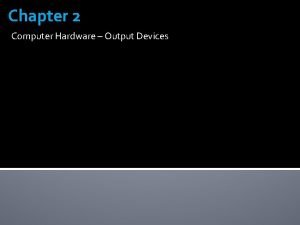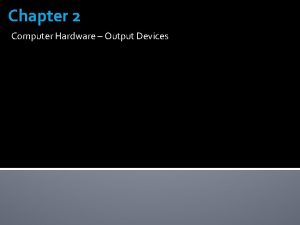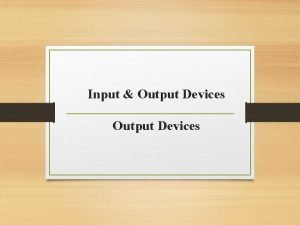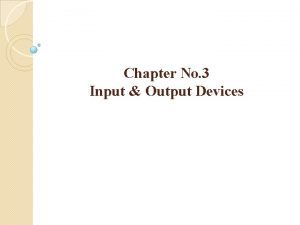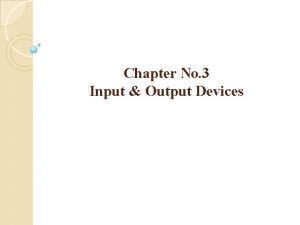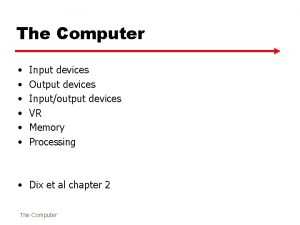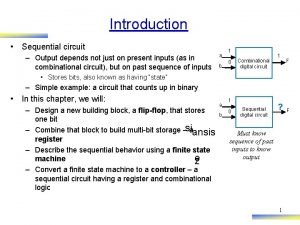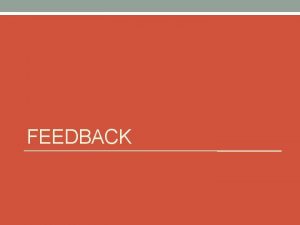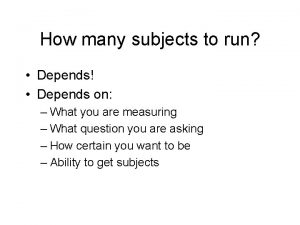Sequential Devices Sequential concept output depends on present





















- Slides: 21

Sequential Devices • Sequential concept: output depends on present as well as past inputs • Past inputs influence operations via memory elements

Sequential Devices • Input (x 1, …, xn), output (z 1, …, zm), present state (y 1, …, yr) and next state (Y 1, …, Yr) are where gi and hi are Boolean functions, or in vector form

Sequential Devices • Concept not limited to digital systems • Example: Elevator; has states: – Current position (floor) – Direction (up/down) – Next state depends on • Inputs (buttons pressed by passengers) • Current state (floor and direction) • State diagrams: graphical representation of sequential circuits – States: denoted by circles – Transitions: by arcs or arrows, labeled with inputs and outputs.

Sequential Devices • State tables: tabular representation of sequential circuits – Present state on the left, input on top – Next state / output is content of table cell

Sequential Devices • Designing a good state representation is the most difficult part of designing sequential circuits • Case in point: elevator – Suppose state contains floor & direction – What happens on 2? 3, 4 2 2, 3, 4 3 2 1 4 1 default 2 ? 3 1, 2, 3

Elevator • Suppose state diagram augmented by adding “hanging” states 4 3, 4 2 1 1 2 2 2 3 1 4 3 3 2 default 4 2 2 1, 2, 3 ? 1, 2 3 – Still problem: what happens in 2 when pressing “ 1”? Still have to remember you had “ 4”?

Elevator • A better approach: bit array 1…n, one per floor 1 2 ………………. n • “ 1” in the table indicates need to stop on that floor; Logic illustrated by program Begin /* the elevator main loop */ if (any bit is non-zero) if (current direction == nil) if (more bits are on above current floor than below) current direction = up else if (more bits are on below current floor than above) current direction = down else current direction = down /* might be random() */ endif /* end direction selection from previously nil */

Elevator begin /* at this point there is non-null direction; go! */ service next floor in current direction; set its bit = 0 until (no more bits are “ 1” in current direction) set current direction = nil /* done with direction, choose another */ else /* no bits were on */ set current direction = nil endif Again /* main loop forever */

Memory Devices • The memory unit is integral part of sequential machines • Memory is “bistable” – is output is either 0 or 1 • Has “excitation” inputs that bring it to the desired state • Commonly used – latches and flip-flops – Latches – typically “transparent”, respond immediately – Flip-flops have clocks, output changes only by clock

Memory Devices • Latch and flip-flop timing

Memory Devices • Simple feedback latches: set latch • Devices that stay permanently in one state are not very useful. Set and reset latches illustrate the concept, and serve as components of the set-reset latch

Memory Devices • Simple feedback latches: reset latch

Memory Devices • Simple feedback latches: set-reset latch

Set-reset latch • When S=R=0 reduces to a pair of crosscoupled inverters (hold state) • This is a stable configuration • When S=1 (R=0) then Q’ 0 • Bringing S back to 0 does not change the outputs; Q=1, Q’=0 (now S=R=0 again) • When R=1 (keeping S=0) then Q 0 • Bringing R back to 0 does not change the outputs; Q=0, Q’=1 • When S=R=1 then Q and Q’ are both 0 – not allowed **note: no oscillations, ckt stable** Q’ Q

Set-reset (SR) latch

SR latch • If S and R are asserted at the same time, output Q is not the complement of Q’ • What happens if S and R are asserted for some time, and then released simultaneously?

SR latch • This diagram assumes the NOR implementation of the SR latch

SR latch • SR latch propagation delays • This diagram assumes the NOR implementation of the SR latch

Gated SR latch • Uses extra control signal to inhibit state changes when the S and R signals are changing

Gated SR latch • Excitation table and state diagram of the gated SR latch

Gated SR latch • Logic function Q* = f(C, S, R, Q) • Q* = C’Q + SC + QR’ Set S = D; R = D’ R’ = D • Q* = C’Q + DC + QD = C’Q + CD (by consensus) • K-map of the gated SR latch SR 4 12 8 CQ 0 • C=0 Q* = Q+QR’ = Q • C=1 Q* = S+QR’ 0 C’Q 1 QR’ 3 SC 2 0 5 1 13 1 7 1 1 0 1 11 X 14 0 0 9 15 6 0 0 1 10 X 1
 What is input device
What is input device Sequential programmable logic devices
Sequential programmable logic devices Sequential devices
Sequential devices Concept of sequential organization in data structure
Concept of sequential organization in data structure Input devices for vr
Input devices for vr Peripheral devices adalah
Peripheral devices adalah Is a laser printer an input or output device
Is a laser printer an input or output device What is output
What is output Dot matrix printer is an example of
Dot matrix printer is an example of Automated input device
Automated input device Conclusion of output devices
Conclusion of output devices Input and output devices for visually impaired
Input and output devices for visually impaired Advantages and disadvantages of output devices
Advantages and disadvantages of output devices Output devices
Output devices Dot
Dot Conclusion of input and output devices
Conclusion of input and output devices Cpu output device
Cpu output device What is tactile output
What is tactile output 5 output devices
5 output devices The large program that controls how the cpu communicates
The large program that controls how the cpu communicates Soft copy output devices
Soft copy output devices Classification of output devices
Classification of output devices

